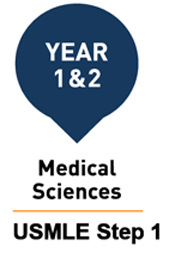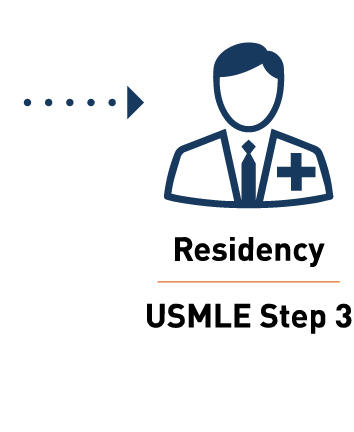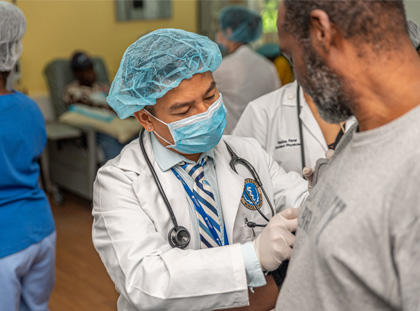Now you want to learn how to become a doctor. What milestones will you need to complete to practice as an MD? The first hurdle in learning how to become a doctor starts with your journey through medical school.
Despite the recession, the current job market makes it a prime time to explore becoming a doctor and pursue a medical education. Employment in healthcare occupations, in general, is projected to grow 15 percent through 2029, adding about 2.4 million new jobs1. The demand for medical doctors continues to increase due in part to an aging and growing population. The U.S. Bureau of Labor Statistics projects jobs for physicians and surgeons will grow by about four percent through 20292. Because becoming a doctor is a long journey, it’s reassuring to know that the demand for doctors will continue to grow and make your medical education worth the effort.
The first challenge - how long does it take to become a doctor?
Obtaining an MD degree typically takes four years of medical school and three to seven years of residency, followed by a possible fellowship of one year or longer. While this is the standard timeframe, the question, “how long does it take to become a doctor?” is subjective. The timeline can depend on several factors such as your start date or curriculum preferences. Ross University School of Medicine (RUSM) offers three start dates each year and the choice of an accelerated vs. non-accelerated curriculum. An optimal time to prepare is between your sophomore and junior years of undergraduate college, but many non-traditional students start preparing after graduation, after a gap year, or later in their career.
Path to becoming a doctor — beginning the journey
Your first milestone will be to apply to medical school. You’ll need to complete several tasks to prepare to apply. We recommend completing them in the order below.
- Request recommendation letters and transcripts from your undergraduate institution
- Take the MCAT exam. (Four parts: biology, chemistry, behavioral and psychology)
- Begin writing your application essays (medical school personal statement, American Medical College Application Service® Work and Activities section)
- Start applying to selected schools: review admissions requirements, complete your application and attend interviews
The process of becoming a doctor
The steps to a medical degree at RUSM are the same as U.S.- based schools, with additional program options to tailor your education and post-graduation experience. Once you’ve been accepted to medical school, you’ll begin your four years of medical training, including United States Medical Licensing Examination® (USMLE) exams, then move on to residency and the licensing exam.
Phase I:
- Years 1 and 2: The Medical Sciences Curriculum (learning the foundations of medicine in classroom and lab-based instruction)
- Passage of the USMLE Step 1
Phase II:
Phase III:
After receiving your Doctor of Medicine degree from RUSM, you’ll move on to post-graduate training and patient care:
- Apply to match into residency
- Residency years (three to seven years; first-year internship, then residency training years)
Phase IV:
- Completion of your final licensing exam
- Fellowship (training in a subspecialty)
- Post-residency
Each year, hundreds of our graduates are matched at leading hospitals across the United States and Canada. Most graduates secure residencies through the National Resident Matching Program®.
The final step before practicing medicine as an MD is the General Exam for the state you wish to practice in or the Board Certification Exam for specific medical specialties. Multiple specialties will require an exam for each specialty you wish to practice.
Ultimately, the path to becoming a doctor requires determination to get through school, a commitment to the profession and dedication to your patients—as well as completion of all the steps to become a doctor.
One of the most important decisions in your career is where to attend medical school. You may want to choose a school that offers hands-on, intensive learning experiences; dedicated academic resources and support; and competitive residency rates; along with a team of advisors to support you on the way to your goal. At RUSM, we believe that all these experiences are necessary for your development as a physician.
An admissions associate can answer any questions about admissions to RUSM and provide additional information to guide you through your application to medical school. You can reach the Admissions Office at 855-637-6778 or email admissions@rossu.edu.
1 Bureau of Labor Statistics, U.S. Department of Labor, Occupational Outlook Handbook, Healthcare, Healthcare Occupations, on the Internet at https://www.bls.gov/ooh/healthcare/home.htm (visited October 25, 2020).
2 Bureau of Labor Statistics, U.S. Department of Labor, Occupational Outlook Handbook, Physicians and Surgeons, on the Internet at https://www.bls.gov/ooh/healthcare/physicians-andsurgeons.htm (visited October 25, 2020).













